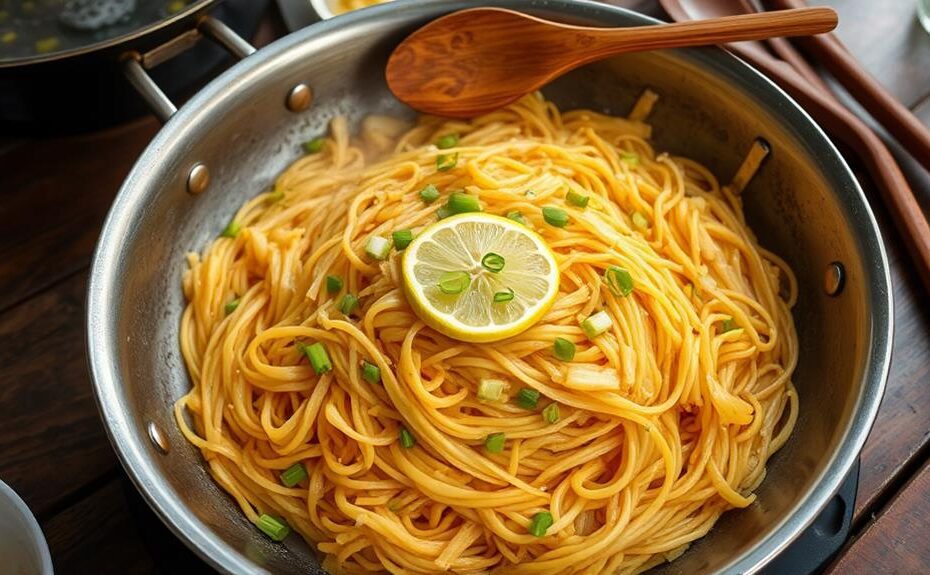Soaking rice noodles is crucial for achieving tender perfection in Pancit. To do this, soak the noodles in warm water for 15-20 minutes.
Creating a flavorful base is essential. Sauté garlic and onion to create a flavorful base, then add your chosen protein and assorted vegetables.
Cook until they are fully cooked and vibrant, ensuring the protein is cooked through and the vegetables are tender-crisp.
Balancing flavors is key. Use low-sodium soy sauce to balance the flavors of your Pancit.
Experiment with oyster sauce for added umami, as it can enhance the dish's overall flavor profile.
By following these expert tips, you'll unlock the secrets to a harmonious Pancit that's sure to impress.
Understanding Pancit Fundamentals
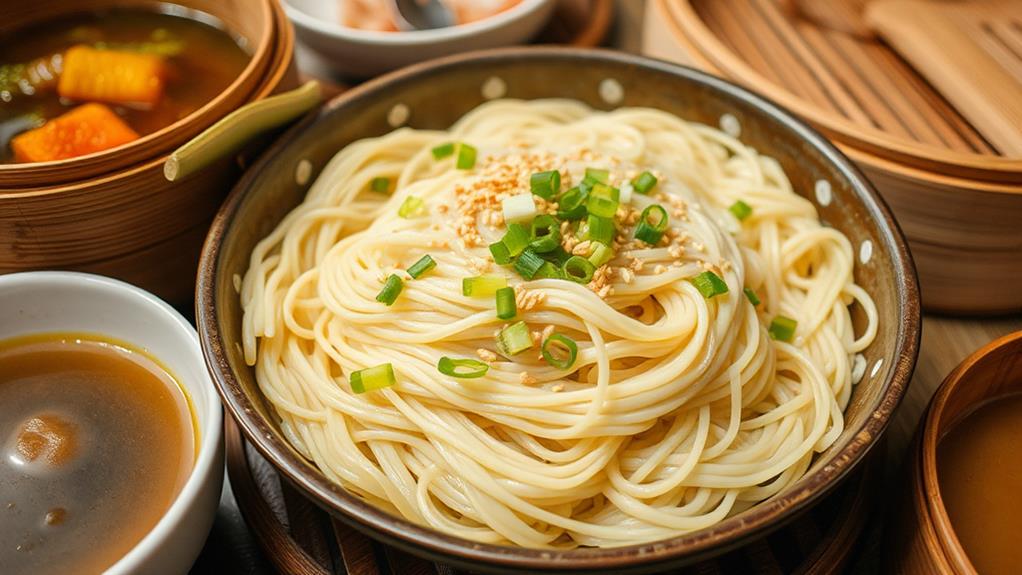
Pancit Fundamentals
Pancit, a traditional Filipino dish, is built upon a rich cultural heritage and fundamental elements that make it a beloved meal.
Rice Noodles: The Foundation
Pancit features rice noodles, which require soaking in warm water to soften before cooking. This crucial step allows the noodles to absorb the flavors of the stir-fry later on.
Flavorful Base
Typically, a flavorful base is created by sautéing garlic and onion. This base is essential for adding depth to the dish.
Protein and Vegetables
Protein options like chicken, shrimp, or pork are added, along with assorted vegetables such as cabbage, carrots, and bell peppers.
Bringing it Together
Finally, the soaked noodles are mixed in, along with a dash of soy sauce, to bring all the flavors together.
Choosing the Right Noodles
Choosing the Right Noodles for Pancit
Traditional Pancit Bihon Noodles
To make a traditional Pancit Bihon, use rice vermicelli noodles that only require soaking in warm water. This allows them to absorb flavors during cooking, giving your dish a more authentic taste.
Pancit Canton Noodles
For a chewier texture, use Pancit Canton noodles, which are made from eggs and provide a heartier consistency compared to rice noodles.
Selecting High-Quality Noodles
When selecting noodles, ensure they're fresh or properly dried, as quality can significantly impact the overall dish flavor and texture.
You can experiment with alternative noodles like udon or chow mein, but keep in mind that they may alter the traditional taste and cooking method of Pancit.
Following Package Instructions
Always check the package instructions for soaking times, as different brands of noodles may have varying requirements for optimal softness.
Essential Ingredients and Substitutions
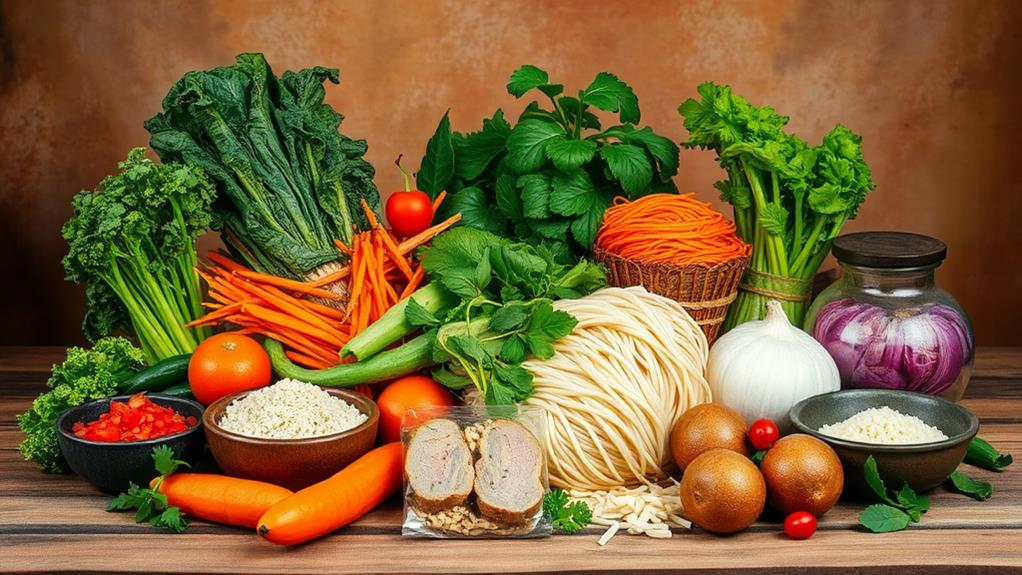
Essential Ingredients for Authentic Pancit
To create an authentic and mouthwatering Pancit dish, certain ingredients are crucial. These essential ingredients include rice noodles (bihon), soy sauce, assorted vegetables, and a protein choice.
Rice Noodles (Bihon)
Rice noodles are light and delicate, providing the foundation for the dish. You can substitute rice noodles with egg noodles (pancit canton), but this will alter the texture and flavor.
Soy Sauce
Soy sauce adds a savory and umami flavor to Pancit. Use low-sodium soy sauce to manage saltiness, or adjust the amount to taste.
Assorted Vegetables
Chopped vegetables are an essential component of Pancit. Choose from carrots, cabbage, green beans, bell peppers, onions, and more, ensuring they're chopped uniformly.
Protein
A protein choice is necessary for added flavor and texture. Select one or combine chicken, shrimp, pork, or other options for optimal results.
Optional Ingredient: Oyster Sauce
Oyster sauce adds a rich, savory flavor to Pancit. Add it for depth, but use it sparingly to avoid overpowering the dish.
Mastering Cooking Techniques and Times
Soaking Rice Noodles: Soak rice noodles in warm water for 15-20 minutes to achieve tender noodles.
Sautéing Aromatics: Sauté garlic and onion over medium heat for 2-3 minutes, until fragrant, to build a flavorful base for the dish.
Cooking Proteins: Add proteins to the pan and cook until they're browned and fully cooked, which usually takes around 5-7 minutes.
Stir-Frying Vegetables: Incorporate vegetables and stir-fry them for 2-3 minutes, until they're tender yet still crisp, to maintain their vibrant color and nutrients.
Balancing Flavors and Seasoning
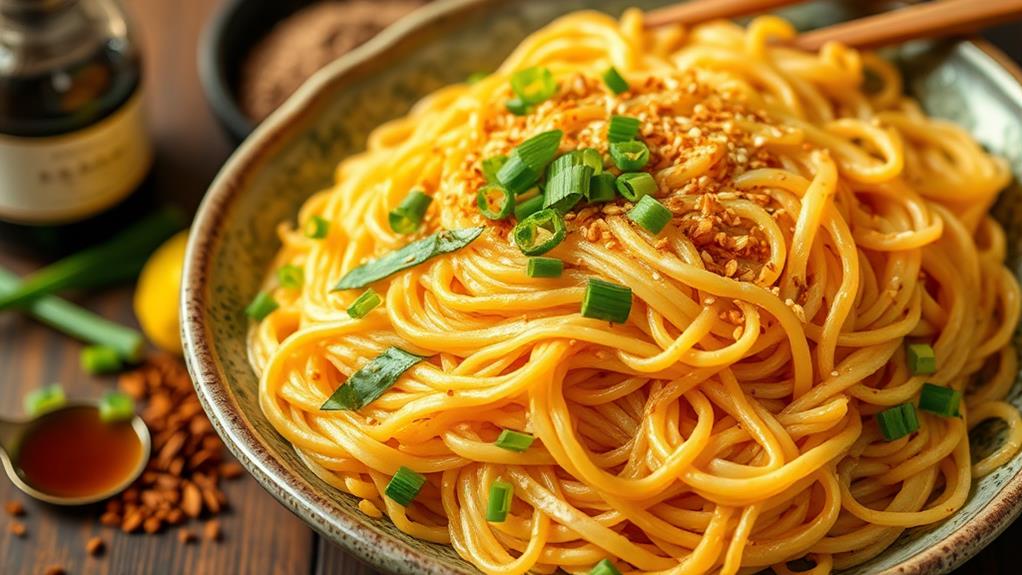
Balancing Flavors and Seasoning in Pancit
To create a well-balanced flavor profile in Pancit, it's crucial to strike a harmonious balance between salty, sweet, sour, and umami notes.
Controlling Saltiness
Use low-sodium soy sauce to maintain a rich flavor profile without overpowering the dish. This allows for a balanced salty flavor that complements the other ingredients.
Adding Depth with Vegetables
Incorporate a variety of fresh vegetables, such as carrots and cabbage, to add layers of flavor and texture that complement the noodles and protein. This adds depth and complexity to the dish.
Elevating Umami Taste
Enhance the dish's depth by adding oyster sauce or fish sauce, which can elevate the umami taste of the overall dish. These ingredients add a rich, savory flavor that complements the other seasonings.
Seasoning Proteins Wisely
Season proteins with salt and pepper before cooking to ensure they absorb flavor and contribute to the overall taste of the Pancit. This ensures that the protein is flavorful and well-seasoned.
Tasting and Adjusting
Remember to always taste and adjust seasonings during the cooking process, as different ingredients can absorb flavors differently, leading to variations in taste.
Serving Suggestions and Garnishes
Elevate the Presentation of Your Pancit
The presentation of your Pancit dish plays a crucial role in enhancing the overall dining experience. Serve it with a slice of lime or calamansi on the side to add a refreshing zest and enhance its flavor. Additionally, garnish it with chopped green onions or cilantro for added freshness and visual appeal.
Traditional Meal Experience
To create a traditional meal experience, pair your Pancit with Filipino lumpia or spring rolls, which provide complementary textures. Offer chili sauce or hot sauce on the side for those who enjoy a spicy kick.
Presenting Pancit for Communal Sharing
Present your Pancit in a large platter to emphasize its role in celebrations and gatherings. This encourages communal sharing and creates a fun, lively atmosphere.
Storage and Reheating Tips
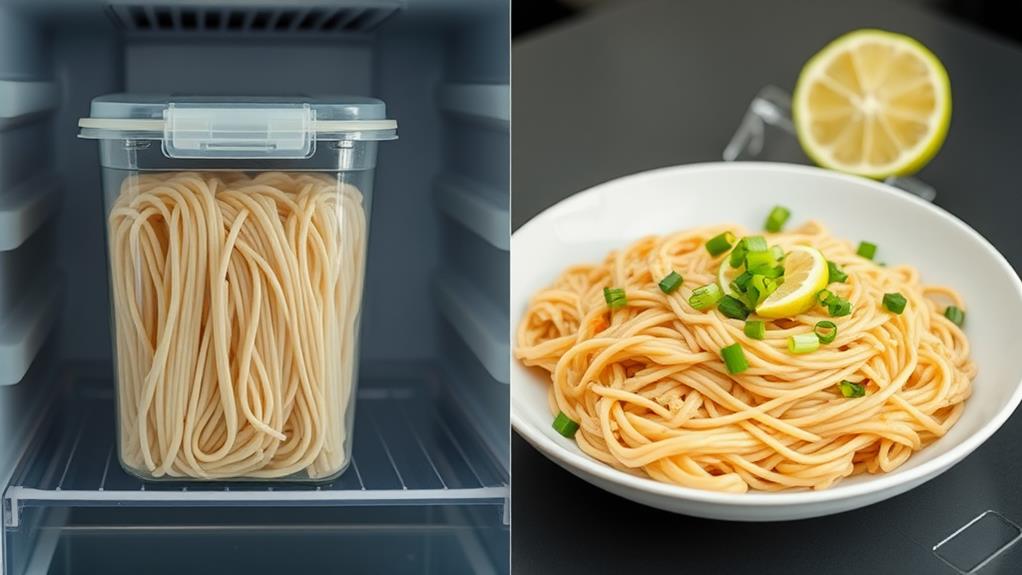
Proper Storage is Crucial for Maintaining Pancit's Quality
To keep your Pancit dish fresh and flavorful, proper storage is essential. Store leftover Pancit in an airtight container in the refrigerator for optimal freshness, ideally consuming it within 2-3 days. This ensures the noodles and vegetables remain fresh and retain their texture.
Freezing Pancit for Longer Storage
If you want to extend the shelf life of your Pancit, freeze it for up to 3 months. However, make sure to cool it completely before transferring it to a freezer-safe container. This prevents the growth of bacteria and maintains the dish's quality.
Separate Storage for Protein, Noodles, and Vegetables
To preserve the individual textures and flavors of the ingredients, store the protein and noodles separately from the vegetables. This helps to maintain their quality for a longer period.
Reheating Pancit without Drying it Out
When reheating Pancit, use low heat on the stovetop and add a splash of water or broth. This helps to maintain the noodles' texture and prevent them from drying out.
Are the Cooking Tips for Pancit Lomi Similar to Cooking Pancit Dish?
When it comes to preparing Pancit Lomi, the best pancit lomi cooking tips may differ slightly from cooking other pancit dishes. While some basic principles of cooking pancit may apply, there are specific techniques and ingredients unique to Pancit Lomi that require special attention for the best results.
Common Mistakes to Avoid
Common Mistakes to Avoid When Cooking Pancit
To ensure a perfectly cooked Pancit dish, it's essential to avoid common mistakes that can ruin the final product.
Over-soaking rice noodles can lead to an unappetizing texture. Soak rice noodles for 15-20 minutes to achieve the right texture.
Unevenly cut vegetables can result in uneven cooking. Cut vegetables uniformly to promote even cooking and prevent some parts from being overcooked or undercooked.
Too much soy sauce can overpower the dish. Start with a small amount of soy sauce and adjust to taste to achieve a balanced flavor.
Overcrowding the pan can lead to steaming instead of stir-frying. Use a large skillet or wok to prevent overcrowding and ensure that ingredients are cooked evenly.
Insufficient seasoning can result in a bland dish. Season during different stages of cooking to layer flavors and achieve a well-balanced taste.
Frequently Asked Questions
Why Is My Pancit Canton Soggy?
Overcooking is a common reason for soggy Pancit Canton. When noodles are cooked for too long, they absorb excess water, leading to a soggy texture.
To avoid this, cook the noodles according to the package instructions and check for doneness by biting into one. If it's still hard in the center, continue cooking in short intervals until it's al dente.
Improper sauce ratio can also cause sogginess. Using too much sauce can make the noodles soggy. Aim for a balanced ratio of noodles to sauce, and adjust to taste.
Adding too many water-releasing vegetables can also contribute to sogginess. Limit the amount of vegetables like cabbage, carrots, and bean sprouts, which release water during cooking.
Instead, opt for vegetables like bok choy, mushrooms, or bell peppers that retain their texture and flavor when cooked.
How Do You Cook Pancit Canton Steps?
To cook Pancit Canton, you need the following ingredients: noodles, protein, and vegetables.
Start by boiling the noodles until they're al dente.
Then, heat oil in a wok to sauté garlic and onion. Add your chosen protein, such as chicken, pork, or shrimp, and cook until it's thoroughly cooked.
Next, add your chosen vegetables, such as cabbage, carrots, and bean sprouts, and cook until they're tender.
What Is the Most Popular Type of Pancit?
Pancit Bihon is the most popular type of pancit, featuring rice vermicelli noodles that are a staple at Filipino celebrations and gatherings.
This type of pancit stands out due to its thin, delicate noodles made from rice flour, which are often served with vegetables, meat or seafood, and a savory sauce.
Other notable variations of pancit include Pancit Canton, which features chewy egg noodles, and Pancit Malabon, which is characterized by thick rice noodles and seafood toppings.
These different types of pancit reflect regional influences and traditional ingredients, showcasing the diversity of Filipino cuisine.
What Is Special About Pancit?
Pancit's rich history dates back to Chinese influences. This Filipino dish has a storied past, with its origins tracing back to the cultural exchange between the Philippines and China.
Regional variations of pancit exist, showcasing its versatility. Different regions in the Philippines have their own unique takes on the dish, with varying combinations of noodles, proteins, and vegetables.
The harmonious blend of soy sauce, garlic, and onions creates a savory flavor profile. These three ingredients are essential to pancit's flavor, with soy sauce providing a salty umami taste, garlic adding a pungency, and onions contributing a sweet and crunchy texture.
Pancit symbolizes long life and good fortune in Filipino culture. This cultural significance is why pancit is often served at festive occasions and family gatherings, such as birthdays and weddings.
